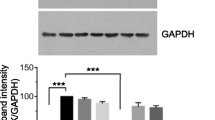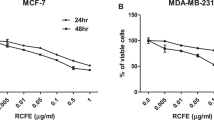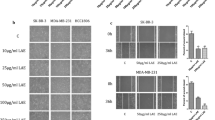Abstract
Metastasis is the most devastating attribute of breast cancer (BC) that leads to high mortality. It is a complex process of tumor cell migration, invasion, and angiogenesis. In this study, we evaluated the effect of ERA on BC metastasis and BC progression in vivo. The transwell invasion/migration and wound healing assays showed that ERA treatment significantly reduced the invasion and migration of BC cell lines. The expression of mesenchymal (E-cadherin and N-cadherin), matrix metalloproteinases (MMP2, MMP9), and stemness markers (Oct3) were down-regulated by ERA. Furthermore, ERA down-regulated angiogenic chemokines (CXCL1/2/3, CXCL5, and CXCL12) expression in the highly metastatic MDA-MB-231 cell line. The clonogenic survival of BC cells was also reduced by ERA treatment. Strikingly, ERA prevented DMBA-induced tumor growth in Swiss albino mice as depicted by a high animal survival rate (84%) in the ERA group and histopathological analysis. Conclusively, this study revealed that ERA possesses anti-metastatic potential and also reduces the growth of BC in vivo. Moreover, the GC–MS data revealed the presence of biologically active compounds (Lupeol, Phytol, phytosterol) and some rare (9, 19-Cyclolanost) phyto metabolites in ERA extract. However, further studies are suggestive to identify and isolate the therapeutic agents from ERA to combat BC and metastasis.






Similar content being viewed by others
Data availability
All data obtained during this study are included in the manuscript.
References
Riggio AI, Varley KE, Welm AL. The lingering mysteries of metastatic recurrence in breast cancer. Br J Cancer. 2021;124:13–26. https://doi.org/10.1038/s41416-020-01161-4.
Miller KD, Nogueira L, Mariotto AB, Rowland JH, Yabroff KR, Alfano CM, et al. Cancer treatment and survivorship statistics, 2019. CA Cancer J Clin. 2019;69:363–85.
Liang Y, Zhang H, Song X, Yang Q. Metastatic heterogeneity of breast cancer: Molecular mechanism and potential therapeutic targets. In.: Elsevier; 2020, 14–27.
Serala K, Steenkamp P, Mampuru L, Prince S, Poopedi K, Mbazima V. In vitro antimetastatic activity of Momordica balsamina crude acetone extract in HT-29 human colon cancer cells. Environ Toxicol. 2021;36:2196–205.
Mrozik KM, Blaschuk OW, Cheong CM, Zannettino ACW, Vandyke K. N-cadherin in cancer metastasis, its emerging role in haematological malignancies and potential as a therapeutic target in cancer. BMC Cancer. 2018;18:1–16.
Palacios-Arreola MI, Nava-Castro KE, Castro JI, García-Zepeda E, Carrero JC, Morales-Montor J. The role of chemokines in breast cancer pathology and its possible use as therapeutic targets. J Immunol Res. 2014;2014.
Choi J, Ahn SS, Lim Y, Lee YH, Shin SY. Inhibitory effect of Alisma canaliculatum ethanolic extract on NF-κB-dependent CXCR3 and CXCL10 expression in TNFα-exposed MDA-MB-231 breast cancer cells. Int J Mol Sci. 2018;19:2607.
Luo K-W, Yue GG-L, Ko C-H, Gao S, Lee JK-M, Li G, et al. The combined use of Camellia sinensis and metronomic zoledronate in 4T1 mouse carcinoma against tumor growth and metastasis. Oncol Rep. 2015;34:477–87.
Lee MM-L, Chan BD, Wong W-Y, Qu Z, Chan M-S, Leung T-W, et al. Anti-cancer activity of Centipeda minima extract in triple negative breast cancer via inhibition of AKT, NF-κB, and STAT3 signaling pathways. Front Oncol. 2020;10:491.
Nho KJ, Chun JM, Kim DS, Kim HK. Ampelopsis japonica ethanol extract suppresses migration and invasion in human MDA-MB-231 breast cancer cells. Mol Med Report. 2015;11:3722–8.
Lai Y-J, Tai C-J, Wang C-W, Choong C-Y, Lee B-H, Shi Y-C, et al. Anti-cancer activity of Solanum nigrum (AESN) through suppression of mitochondrial function and epithelial-mesenchymal transition (EMT) in breast cancer cells. Molecules. 2016;21:553.
Yang B, Wang N, Wang S, Li X, Zheng Y, Li M, et al. Network-pharmacology-based identification of caveolin-1 as a key target of Oldenlandia diffusa to suppress breast cancer metastasis. Biomed Pharmacother. 2019;112: 108607.
Wrighton KC, Thrash JC, Melnyk RA, Bigi JP, Byrne-Bailey KG, Remis JP, et al. Evidence for direct electron transfer by a Gram-positive bacterium isolated from a microbial fuel cell. Appl Environ Microbiol. 2011;77:7633–9.
Park J, Jeong D, Song M, Kim B. Recent advances in anti-metastatic approaches of herbal medicines in 5 major cancers: from traditional medicine to modern drug discovery. Antioxidants (Basel). 2021;10:527. https://doi.org/10.3390/antiox10040527.
Mwine TJ, Damme VP. Why do Euphorbiaceae tick as medicinal plants? A review of Euphorbiaceae family and its medicinal features. 2011.
Ashraf A, Sarfraz RA, Rashid MA, Shahid M. Antioxidant, antimicrobial, antitumor, and cytotoxic activities of an important medicinal plant (Euphorbia royleana) from Pakistan. JFDA. 2015;23:109–15.
Ebrahim HY, Osman SA, Haffez HR, Hassan ZA. In-vitro screening of some plant extracts for their potential anticancer activity. Afr J Tradit Complement Altern Med. 2020;17:1–8.
Gull S, Farooq K, Tayyeb A, Arshad MI, Shahzad N. Ethanolic extracts of Pakistani euphorbiaceous plants induce apoptosis in breast cancer cells through induction of DNA damage and caspase-dependent pathway. Gene. 2022;824: 146401.
Aftab S, Khalid Z, Shakoori AR. Repression of Cell-to-Matrix Adhesion by Metformin Chloride Supports Its Anti-Metastatic Potential in an In Vitro Study on Metastatic and Non-Metastatic Cancer Cells. Critical Reviews™ in Eukaryotic Gene Expression. 2022;32.
Maskey N, Li D, Xu H, Song H, Wu C, Hua K, et al. MicroRNA-340 inhibits invasion and metastasis by downregulating ROCK1 in breast cancer cells. Oncol Lett. 2017;14:2261–7.
Naz H, Gull S, Bashir Q, Rashid N, Shahzad N. Thermococcus kodakarensis-derived L-asparaginase: a candidate for the treatment of glioblastoma. Biologia. 2021;76:1305–14.
Perveen S, Ashfaq H, Ambreen S, Ashfaq I, Kanwal Z, Tayyeb A. Methanolic extract of Citrullus colocynthis suppresses growth and proliferation of breast cancer cells through regulation of cell cycle. Saudi J Biol Sci. 2021;28:879–86.
Srinivasan A, Thangavel C, Liu Y, Shoyele S, Den RB, Selvakumar P, et al. Quercetin regulates β-catenin signaling and reduces the migration of triple negative breast cancer. Mol Carcinog. 2016;55:743–56.
Toulza F, Eliaou JF, Pinet V. Breast tumor cell soluble factors induce monocytes to produce angiogenic but not angiostatic CXC chemokines. Int J Cancer. 2005;115:429–36.
SenGupta S, Hein LE, Xu Y, Zhang J, Konwerski JR, Li Y, et al. Triple-negative breast cancer cells recruit neutrophils by secreting TGF-β and CXCR2 ligands. Front Immunol. 2021;12: 659996.
Ling G-Q, Chen D-B, Wang B-Q, Zhang L-S. Expression of the pluripotency markers Oct3/4, Nanog and Sox2 in human breast cancer cell lines. Oncol Lett. 2012;4:1264–8.
Rashed K. Beta-Sitosterol Medicinal Properties: A Review Article. Int J Sci Inventions Today, IJSIT, 2020, 9 (4). 2020:208–12.
Chen W, Zhou S, Mao L, Zhang H, Sun D, Zhang J, et al. Crosstalk between TGF-β signaling and miRNAs in breast cancer metastasis. Tumor Biol. 2016;37:10011–9.
Morini M, Mottolese M, Ferrari N, Ghiorzo F, Buglioni S, Mortarini R, et al. The α3β1 integrin is associated with mammary carcinoma cell metastasis, invasion, and gelatinase B (mmp-9) activity. Int J Cancer. 2000;87:336–42.
Al-Zharani M, Nasr FA, Abutaha N, Alqahtani AS, Noman OM, Mubarak M, et al. Apoptotic induction and anti-migratory effects of Rhazya stricta fruit extracts on a human breast cancer cell line. Molecules. 2019;24:3968.
Lee HS, Na MH, Kim WK. α-Lipoic acid reduces matrix metalloproteinase activity in MDA-MB-231 human breast cancer cells. Nutr Res. 2010;30:403–9.
Gallardo M, Calaf GM. Curcumin inhibits invasive capabilities through epithelial mesenchymal transition in breast cancer cell lines. Int J Oncol. 2016;49:1019–27.
Balkwill F. Cancer and the chemokine network. Nat Rev Cancer. 2004;4:540–50.
Chen E, Qin X, Peng K, Xu X, Li W, Cheng X, et al. Identification of potential therapeutic targets among CXC chemokines in breast tumor microenvironment using integrative bioinformatics analysis. Cell Physiol Biochem. 2018;45:1731–46.
Bachmeier BE, Mohrenz IV, Mirisola V, Schleicher E, Romeo F, Höhneke C, et al. Curcumin downregulates the inflammatory cytokines CXCL1 and-2 in breast cancer cells via NFκB. Carcinogenesis. 2008;29:779–89.
Minn AJ, Gupta GP, Siegel PM, Bos PD, Shu W, Giri DD, et al. Genes that mediate breast cancer metastasis to lung. Nature. 2005;436:518–24.
Lu M, Xu X, Lu H, Lu Z, Xu B, Tan C, et al. Evaluation of anti-tumor and chemoresistance-lowering effects of pectolinarigenin from Cirsium japonicum Fisch ex DC in breast cancer. Trop J Pharm Res. 2016;15:547–53.
Jeter CR, Badeaux M, Choy G, Chandra D, Patrawala L, Liu C, et al. Functional evidence that the self-renewal gene NANOG regulates human tumor development. Stem cells. 2009;27:993–1005.
Alessandra-Perini J, Perini JA, Rodrigues-Baptista KC, de Moura RS, Junior AP, Dos Santos TA, et al. Euterpe oleracea extract inhibits tumorigenesis effect of the chemical carcinogen DMBA in breast experimental cancer. BMC Complement Altern Med. 2018;18:1–11.
Yousefnia S, Naseri D, Seyed Forootan F, Tabatabaeian M, Moattar F, Ghafghazi T, et al. Suppressive role of Viola odorata extract on malignant characters of mammosphere-derived breast cancer stem cells. Clin Transl Oncol. 2020;22:1619–34.
Liu Y, Li C-L, Xu Q-Q, Cheng D, Liu K-D, Sun Z-Q. Quercetin inhibits invasion and angiogenesis of esophageal cancer cells. Pathol Res Pract. 2021;222: 153455.
Salama YA, El-Karef A, El Gayyar AM, Abdel-Rahman N. Beyond its antioxidant properties: Quercetin targets multiple signalling pathways in hepatocellular carcinoma in rats. Life Sci. 2019;236: 116933.
Carrano R, Grande M, Leti Maggio E, Zucca C, Bei R, Palumbo C, et al. Dietary Polyphenols Effects on Focal Adhesion Plaques and Metalloproteinases in Cancer Invasiveness. Biomedicines. 2024;12:482.
Kuo C-L, Lai K-C, Ma Y-S, Weng S-W, Lin J-P, Chung J-G. Gallic acid inhibits migration and invasion of SCC-4 human oral cancer cells through actions of NF-κB, Ras and matrix metalloproteinase-2 and-9. Oncol Rep. 2014;32:355–61.
Boubaker J, Ben Toumia I, Sassi A, Bzouich-Mokded I, Ghoul Mazgar S, Sioud F, et al. Antitumoral potency by immunomodulation of chloroform extract from leaves of Nitraria retusa, Tunisian medicinal plant, via its major compounds β-sitosterol and palmitic acid in BALB/c mice bearing induced tumor. Nutr Cancer. 2018;70:650–62.
Alqahtani FY, Aleanizy FS, Mahmoud AZ, Farshori NN, Alfaraj R, Al-Sheddi ES, et al. Chemical composition and antimicrobial, antioxidant, and anti-inflammatory activities of Lepidium sativum seed oil. Saudi J Biol Sci. 2019;26:1089–92.
Izu GO, Adeyi AO, Erukainure OL, Islam MS. Gamma-sitosterol–rich fraction from the methanolic extract of Ficus exasperata restores diabetes associated pathophysiological alterations in an alloxan-induced diabetic rats. Biokemistri. 2022;33.
Santos CCdMP, Salvadori MS, Mota VG, Costa LM, de Almeida AAC, de Oliveira GAL, et al. Antinociceptive and antioxidant activities of phytol in vivo and in vitro models. Neurosci J. 2013;2013.
Galli F, Azzi A, Birringer M, Cook-Mills JM, Eggersdorfer M, Frank J, et al. Vitamin E: emerging aspects and new directions. Free Radical Biol Med. 2017;102:16–36.
Wal A, Srivastava R, Wal P, Rai A, Sharma S. Lupeol as a magical drug. Pharm Biol Eval. 2015;2:142–51.
Acknowledgements
We are obliged to the School of Biological Sciences (SBS), PU, and Dr. Muhammad Ali (in charge of animal house) to provide us animal house facility, to conduct in vivo study as well as other basic research facilities. We are thankful to Miss Kokab Farooq for performing the spheroid formation assay as a part of our revised manuscript.
Funding
We are thankful to Higher Education Commission (HEC) Pakistan for funding this research under National Research Program for Universities (NRPU) project (6758/Punjab/NRPU/R&D/HEC/2016).
Author information
Authors and Affiliations
Contributions
SG contributed to the study design and performed the experiments. FT and IA data interpretation, and manuscript preparation. MAS, AT, LA, MA, and MIA provided research material and performed the statistical analysis. NS Conceptualization, supervision, revising, and editing the paper. All authors read and approved the final manuscript.
Corresponding author
Ethics declarations
Conflict of interest
The authors declare that they have no competing interests.
Research involving human participants
The study did not involve Human participants.
Additional information
Publisher's Note
Springer Nature remains neutral with regard to jurisdictional claims in published maps and institutional affiliations.
Rights and permissions
Springer Nature or its licensor (e.g. a society or other partner) holds exclusive rights to this article under a publishing agreement with the author(s) or other rightsholder(s); author self-archiving of the accepted manuscript version of this article is solely governed by the terms of such publishing agreement and applicable law.
About this article
Cite this article
Gull, S., Tasneem, F., Ahmed, I. et al. Ethanolic extract of Euphorbia royleana Boiss. reduces metastasis of breast cancer cells and inhibits tumor progression in vivo. Med Oncol 41, 152 (2024). https://doi.org/10.1007/s12032-024-02378-6
Received:
Accepted:
Published:
DOI: https://doi.org/10.1007/s12032-024-02378-6




